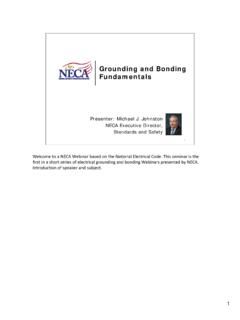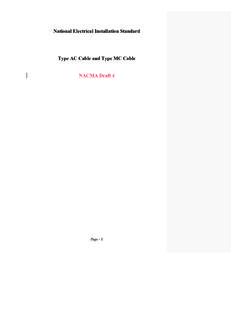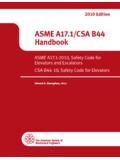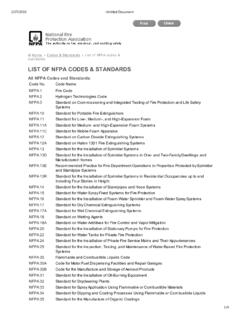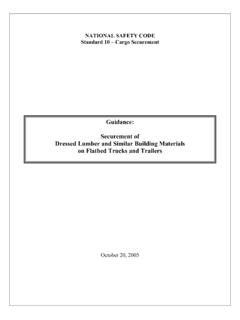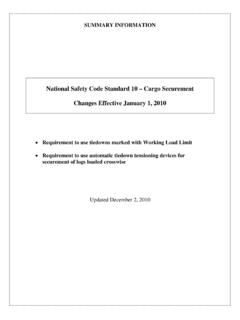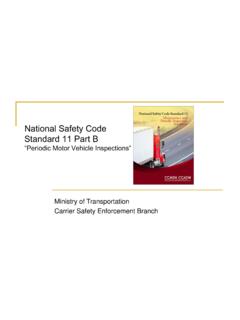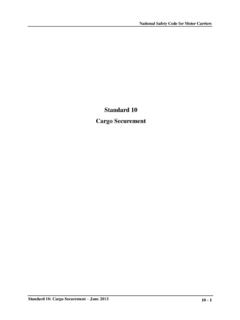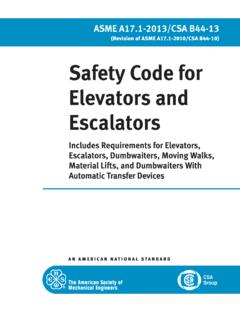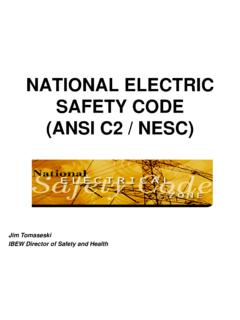Transcription of Standard for Installing and Testing Fiber Optics
1 An AmericAn national StAndArdNECA/FOA 301-2009 Standard forInstalling and TestingFiber OpticsPublished byNational Electrical Contractors AssociationJointly developed withThe Fiber Optic AssociationTheFiberOpticAssociationFOAFO A Member Copy Courtesy of NECA and the Fiber Optic AssociationTMNationalElectricalInstallat ionStandards TheFiberOpticAssociationFOAS tandard forInstalling and TestingFiber Optic CablesNECA/FOA301-2009 AnAmericanNationalStandard Jointly developed withThe Fiber Optic AssociationTheFiberOpticAssociationFOAP ublished byNational ElectricalContractors AssociationFOA Member Copy For Individual Use Only<This page intentionally left blank>FOA Member Copy For Individual Use Onlyiii Foreword ..v1. Scope .. Products and Applications Included .. Regulatory and Other Requirements .. Fiber Optic Topologies ..12. Definitions,Abbreviations,and Acronyms.
2 Definitions .. Abbreviations and Acronyms ..63. Safetyand Cautions forFiberOpticInstallation .. Fiber Optic Installation safety .. Cleanliness ..84. Installation Requirements .. General Guidelines .. Support Structures .. Removal of Abandoned Cables .. Fire Stopping .. Grounding and Bonding ..105. FiberOpticCables .. Cable Types .. Flammability Rating Cable Ratings and Markings .. Fiber Optic Cable Color Codes .. Installing Fiber Optic Cable .. Cable Plant Hardware .. Use of Cable Ties ..156. FiberOpticTemination .. General Guidelines .. Fiber Optic Connections .. Splicing ..177. Testing the Installed FiberOpticCable Plant .. General Guidelines .. Continuity Testing ..19 Table ofContentsFOA Member Copy For Individual Use Only Insertion Loss .. OTDR Testing ..198. Administration,Management,and Guidelines.
3 21 AnnexA:Calculating the Loss Budget fora FiberOpticCable Plant ..22 AnnexB:FieldTest Requirements ..25 AnnexC:Reference standards ..28 NECA/FOA301 Standard for Installing and Testing Fiber Optic CablesFOA Member Copy For Individual Use Onlyv national Electrical Installation standards aredesigned to improve communication among speci-fiers, purchasers, and suppliers of electrical construc-tion services. They define a minimum baseline ofquality and workmanship for Installing electricalproducts and are intended to be ref-erenced in contract documents for electrical con-struction projects. The following language is recom-mended: Fiber optic cables shall be installed in accordancewith NECA/FOA 301, Standard for Installing andTesting Fiber Optic ofNEIS is voluntary, and neither the NationalElectrical Contractors Association nor the FiberOptic Association assumes any obligation or liabilityto users of this publication.
4 Existence of a standardshall not preclude any member or nonmember ofNECA or FOA from specifying or using alternateconstruction methods permitted by applicable installation and maintenance practices recom-mended by this publication are intended tocomply with the edition of the national ElectricalCode (NEC) in effect at the time of they are quality standards ,NEIS may insome instances go beyond the minimum require-ments of the NEC. It is the responsibility of users ofthis Standard to comply with state and local electricalcodes when Installing electrical products and for revisions and improvements to thisstandard are welcome. They should be addressed to:NECA Codes and Standards3 Bethesda Metro Center, Suite 1100 Bethesda, MD 20814(301) 215-4521 telephone(301) 215-4500 purchaseNational Electrical Installation standards ,contact the NECA Order Desk at (301) 215-4504 tel,(301) 215-4500 fax, can also be purchased in.
5 Pdf downloadformat 2009, national Electrical ContractorsAssociation. All rights reserved. Unauthorized repro-duction Electrical Installation StandardsandNEIS aretrademarks of the national Electrical ContractorsAssociation. national Electrical code and NEC are regis-tered trademarks of the national Fire ProtectionAssociation, Quincy, (This foreword is not a part of the Standard )FOA Member Copy For Individual Use Only<This page intentionally left blank>FOA Member Copy For Individual Use Only1 This Standard describes procedures for Installing andtesting cabling networks that use Fiber optic cablesand related components to carry signals for commu-nications, security, control and similar purposes. Itdefines a minimum level of quality for Fiber opticcable Products and Applications IncludedThis Standard covers Fiber optic cabling installedindoors (premises installations) with the addition ofoutside plant (OSP) applications involved in campusinstallations where the Fiber optic cabling extendsbetween Regulatoryand OtherRequirementsThis publication is intended to comply withANSI/NFPA 70, the national Electrical code (NEC).
6 It is the responsibility of users of this publication tocomply with state and local electrical codes, OSHA occupational safety regulations as well as follow man-ufacturer s installation instructions when installingelectrical products and information in this publication is also intendedto comply with the following: ANSI/IEEE C2-2007, national Electrical SafetyCode ANSI/TIA/EIA 568-C, Commercial BuildingTelecommunications Cabling Standard ANSI/TIA/EIA 569-B, Commercial BuildingStandard for Telecommunications WiringPathways and Spaces ANSI/TIA/EIA 606-A, Administration Standardfor Commercial TelecommunicationsInfrastructure ANSI/TIA/EIA 607-A, Commercial BuildingGrounding and Bonding Requirements forTelecommunications NECA/BICSI 568-2006 Standard for InstallingCommercial Building TelecommunicationCabling (ANSI)Only qualified persons familiar with installation andtesting of Fiber optic cabling should perform thework described in this publication.
7 The term quali-fied person is defined in Article 100 of the Electrical Installation Standardspro-vide additional guidance for Installing particulartypes of electrical products and systems. A completelist ofNEISis provided in Annex Fiber Optic Association, Inc., the professionalsociety of Fiber Optics , maintains an extensive techni-cal reference web site on Fiber Optics . This websitecovers topics related to Fiber optic technology, com-ponents, installation, Testing , troubleshooting andstandards in depth. Visit formore complete premises applications, Fiber optic cables can beused as the backbone cabling in a Standard struc-tured cabling network, connecting network hardwarein the computer room/main cross connect to localnetwork hardware in a telecom an optimized Fiber optic network, cables go direct-ly to the work area with only passive connections inthe links. This architecture is called centralized fiberoptic cabling.
8 Backbone cables typically containlarger numbers of fibers than horizontal Fiber Member Copy For Individual Use Onlycables, and may contain singlemode fibers as well asmultimode optic cabling can be used for computer net-works (LANs), closed circuit TV (video), voice links(telephone, intercom, audio), building management,security or fire alarm systems, or any other commu-nications plant (OSP) Fiber optic cable installations aretypically point-to-point links with terminationsinside buildings and intermediate connections insealed for Installing and Testing Fiber Optic Cables 2 Figure 2. Cabling for centralized Fiber DistributionNetworkEquipmentFigure 1. Structured cabling architecture per TIA/EIA (Backbone)HorizontalTelecom Rooms(Closet)MainCross-connectIntermedia teCross-connectLAN per EIA/TIA 568 LAN with optimized Fiber opticsFOA Member Copy For Individual Use reduction in optical poweras it passes along a Fiber , usuallyexpressed in decibels (dB).
9 Seeoptical of Fiber per unitCoefficientlength, expressed in scattering of light in a fiberback toward the source, used tomake OTDR (Optical TimeDomain Reflect-o-meter) range of signal frequenciesor bit rates within which a fiberoptic component, link or net-work will orLoss in Fiber caused by stress onMicrobending Lossthe Fiber bent around a restric-tive radius. Most Fiber opticcables are specified for a radiusof 10 times the cable diameterunloaded or 20 times the cablediameter under pulling protective plastic coatingapplied directly to the opticalfiber. Also calledprimary or more fibers enclosed inprotective coverings andstrength combination of Fiber opticcable sections, connectors andsplices forming the optical pathbetween two terminal lower refractive index opti-cal coating over the core of thefiber that traps light into cable containing both opticalCablefibers and electrical device that provides a de-mountable connection betweentwo fibers or a Fiber and anactive visible light source used toconfirm continuity and center of the optical fiberthrough which light is (dB)A unit of measurement of opti-cal power that indicates relativepower on a logarithmic = 10 log (power ratio).
10 DispersionThe spreading of a pulse in anoptical wave-guide that affectsbandwidth. May be caused bymodal or chromatic ,Abbreviations,andAcronyms3 FOA Member Copy For Individual Use OnlyEndFinishThe quality of the end surfaceof a Fiber prepared for splicingor terminated in a connector,tested by visual inspection in precision tube, which holds afiber in alignment for intercon-nection or termination. A fer-rule may be part of a connectoror mechanical transmission throughflexible transmissive fibers forcommunications or reflected from the cleavedReflectionor polished end of a fibercaused by the difference ofrefractive indices of air andglass. Also calledBack ReflectionorOptical Return permanent joint between twofibers created by heating thefibers and fusing the precision instrument thatjoins two fibers together bymelting and fusing them, typi-cally with an electric type of multimode Fiber ,Fiberwhich uses a graded profile ofrefractive index in the corematerial to correct for optical cable containingboth singlemode and multi-mode fluid or gel with a refractiveFluidorGelindex similar to the Fiber usedto match the materials at theends of two fibers to reduce lossand back loss caused by the insertionof a component such as a spliceor connector in an optical refers to the loss of a cableor cable plant when tested withan optical loss test protective outer layer of Greek letter used as a symbolfor high quality Fiber optic refer-ence jumper cable used for losstesting.
